A new low below 3,220.51 and the narrow channel about most recent upwards movement suggests a fourth wave correction may have arrived. Fibonacci ratios and the fourth wave of one lesser degree are used to estimate a target for support.
Summary: Minor wave 4 should last about two weeks or so and may find support about 3,098.
Thereafter, the next target is at 3,302 for a larger fourth wave correction and then 3,336 for an even larger fourth wave correction.
Alternatively, if price makes a new high tomorrow, then the short-term target would be at 3,264.
Three large pullbacks or consolidations (fourth waves) during the next 1-2 years are expected: for minor wave 4 (coming soon), then intermediate (4), and then primary 4. Some weakness prior to each of these corrections may be evident in technical analysis. Weakness is now evident in VIX, and conditions are becoming extreme. Extreme conditions warrant more careful attention to risk management at this time.
The biggest picture, Grand Super Cycle analysis, is here.
Monthly charts were last published here, with video here. There are two further alternate monthly charts here, with video here.
ELLIOTT WAVE COUNTS
The two weekly Elliott wave counts below will be labelled First and Second. They may be about of even probability. When the fifth wave currently unfolding on weekly charts may be complete, then these two wave counts will diverge on the severity of the expected following bear market. To see an illustration of this future divergence monthly charts should be viewed.
FIRST WAVE COUNT
WEEKLY CHART
The basic Elliott wave structure consists of a five wave structure up followed by a three wave structure down (for a bull market). This wave count sees the bull market beginning in March 2009 as an incomplete five wave impulse and now within the last fifth wave, which is labelled cycle wave V. This impulse is best viewed on monthly charts. The weekly chart focusses on the end of it.
Elliott wave is fractal. This fifth wave labelled cycle wave V may end a larger fifth wave labelled Super Cycle wave (V), which may end a larger first wave labelled Grand Super Cycle wave I.
The teal Elliott channel is drawn using Elliott’s first technique about the impulse of Super Cycle wave (V). Draw the first trend line from the end of cycle wave I (off to the left of the chart, the weekly candlestick beginning 30th November 2014) to the end of cycle wave III, then place a parallel copy on the end of cycle wave II. This channel perfectly shows where cycle wave IV ended at support. The strongest portion of cycle wave III, the end of primary wave 3, overshoots the upper edge of the channel. This is a typical look for a third wave and suggests the channel is drawn correctly and the way the impulse is counted is correct.
Within Super Cycle wave (V), cycle wave III is shorter than cycle wave I. A core Elliott wave rule states that a third wave may never be the shortest. For this rule to be met in this instance, cycle wave V may not be longer in length than cycle wave III. This limit is at 3,477.39.
Cycle wave V may subdivide either as an impulse or an ending diagonal. Impulses are much more common. An alternative wave count which considered an ending diagonal has been invalidated. While it is possible a diagonal may become an alternate wave count in coming weeks or months, at this stage the structure does not fit.
At this stage, cycle wave V may take another one to two or so years to complete.
The daily chart below will focus on movement from the end of intermediate wave (2) within primary wave 3.
In historic analysis, two further monthly charts have been published that do not have a limit to upwards movement and are more bullish than this wave count. Members are encouraged to consider those possibilities (links below summary) alongside the wave counts presented on a daily and weekly basis. It is my judgement that the two weekly wave counts published in this analysis have the highest probability, so they shall be the only wave counts published on a daily basis.
Within cycle wave V, primary waves 1 and 2 may be complete. Within primary wave 3, intermediate waves (1) and (2) may be complete. Within the middle of intermediate wave (3), no second wave correction may move beyond its start below 2,855.96.
DAILY CHART
All of primary wave 3, intermediate wave (3) and minor wave 3 may only subdivide as impulses.
Minor wave 3 has passed 1.618 the length of minor wave 1, and within it minute wave v has passed equality in length with minute wave i.
Today it looks more likely that minute wave v within minor wave 3 may be complete. The main hourly wave count below follows this possibility.
If price makes a new all time high again tomorrow, then the alternate hourly wave count below follows the possibility that minor wave 3 may still be incomplete.
Minor wave 2 was a sharp deep pullback, so minor wave 4 may be expected to be a very shallow sideways consolidation to exhibit alternation. Minor wave 2 lasted 2 weeks. Minor wave 4 may be about the same duration, or it may be a longer lasting consolidation. Minor wave 4 may end within the price territory of the fourth wave of one lesser degree; minute wave iv has its range from 3,154.26 to 3,070.49.
Minor wave 4 may not move into minor wave 1 price territory below 3,021.99.
Intermediate wave (3) has now moved far enough above the end of intermediate wave (1) to allow intermediate wave (4) to unfold and remain above intermediate wave (1) price territory.
Draw an Elliott channel now about intermediate wave (3): draw the first trend line from the end of minor wave 1 to the end of minor wave 3, then place a parallel copy on the end of minor wave 2. Minor wave 4 may find support at the lower edge of this channel if it is long lasting or deep enough.
MAIN HOURLY CHART
Minute wave v may be a complete impulse. Fibonacci ratios within it are noted on the chart.
Downwards movement in this last session has broken below the lower edge of the best fit channel.
Minor wave 2 subdivided as a zigzag. Given the guideline of alternation, minor wave 4 is least likely to subdivide as a zigzag and most likely to subdivide as one of either a flat, combination or triangle. Within all of these structures, the first movement subdivides as a three, usually a zigzag.
Within the first three down, no second wave correction nor B wave may move beyond the start of wave A above 3,247.93.
When the first three down may be complete, then the upper invalidation point no longer applies. If minor wave 4 subdivides as any one of an expanded flat, running triangle or combination, then it may include a new high for wave B or X as part of the structure.
If price makes a new high tomorrow, then use the alternate wave count below.
ALTERNATE HOURLY CHART
With some adjustment to how the small subdivisions in minor wave 3 are seen, it is possible that minor wave 3 may be incomplete and minor wave 4 may not have yet begun.
This best fit channel is redrawn to contain all upwards movement. If this wave count is correct, then the lower edge should provide support. If this channel is breached tomorrow, then the probability of this alternate wave count would reduce.
Minuette wave (iv) may not move into minuette wave (i) price territory below 3,118.02.
SECOND WAVE COUNT
WEEKLY CHART
This weekly chart is almost identical to the first weekly chart, with the sole exception being the degree of labelling.
This weekly chart moves the degree of labelling for the impulse beginning in March 2009 all down one degree. This difference is best viewed on monthly charts.
The impulse is still viewed as nearing an end; a fifth wave is still seen as needing to complete higher. This wave count labels it primary wave 5. Primary wave 5 may still need another year to two or so to complete, depending upon how time consuming the corrections within it may be.
Primary wave 5 may be subdividing as an impulse, in the same way that cycle wave V is seen for the first weekly chart.
TECHNICAL ANALYSIS
MONTHLY CHART

Click chart to enlarge. Chart courtesy of StockCharts.com.
There are three large consolidations noted on this chart, in shaded areas. After a breakout from a multi-month consolidation, it is reasonable to expect a multi month bullish move may result.
Note that in each of the first two cases a pullback saw price re-enter the consolidation zone after the breakout, before price then moved up and away. It is possible that may happen again after the last breakout from a consolidation.
This chart very clearly exhibits rising price on declining volume has now persisted for several years. A decline in volume last month, in current market conditions, is not of concern.
On Balance Volume supports the Elliott wave count.
WEEKLY CHART
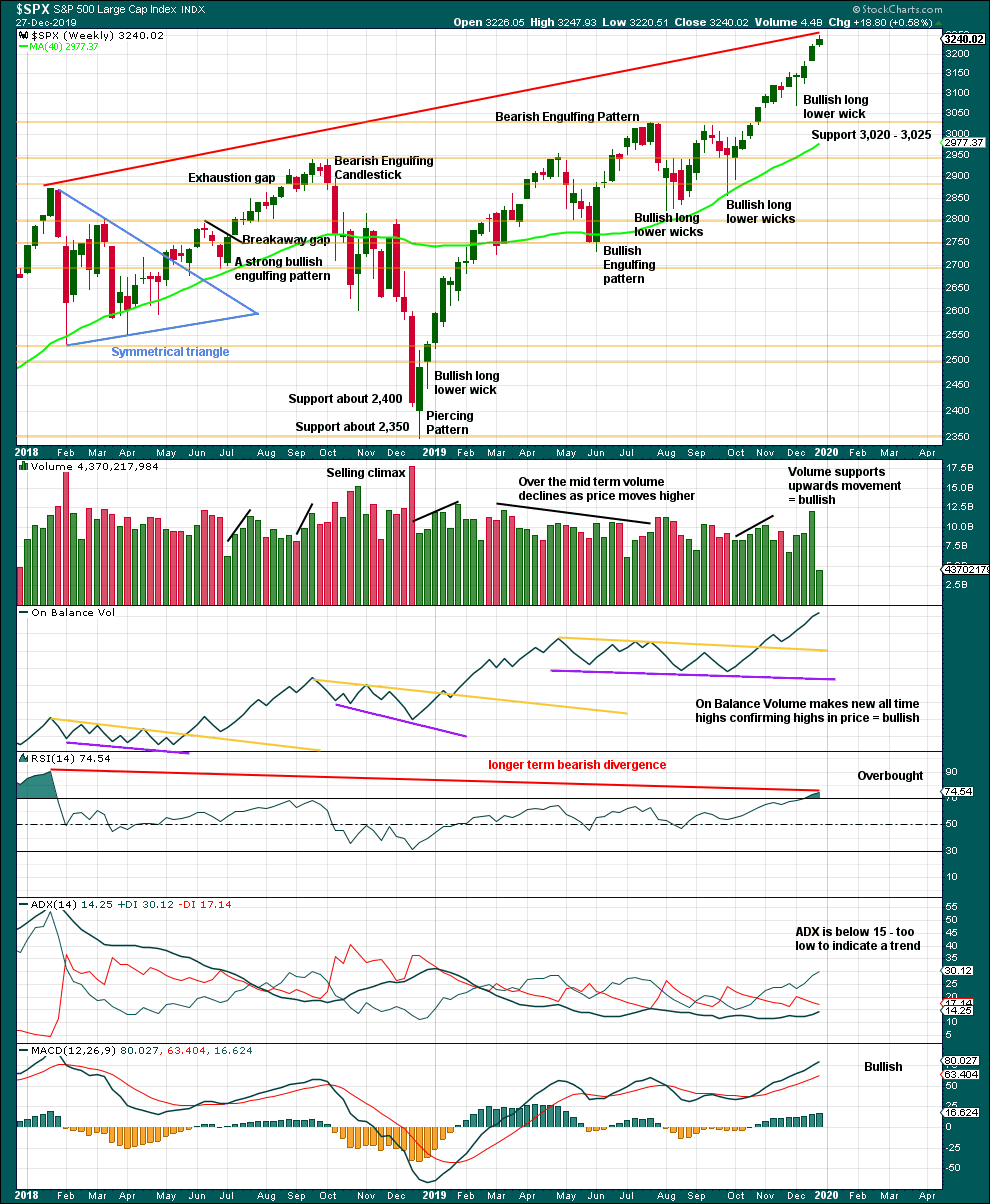
Click chart to enlarge. Chart courtesy of StockCharts.com.
It is very clear that the S&P is in an upwards trend and the bull market is continuing. Price does not move in straight lines; there will be pullbacks and consolidations along the way.
This chart is overall bullish. There are no signs of weakness in upwards movement.
RSI is now overbought. That does not mean upwards movement must end here, because it can continue for several weeks while RSI reaches more extreme. RSI reaching overbought is a warning that conditions are now becoming extreme. A pullback or consolidation will follow and the longer conditions are extreme the closer this will be. However, assume the trend remains the same until proven otherwise. This warning should be heeded by careful attention to risk management.
DAILY CHART
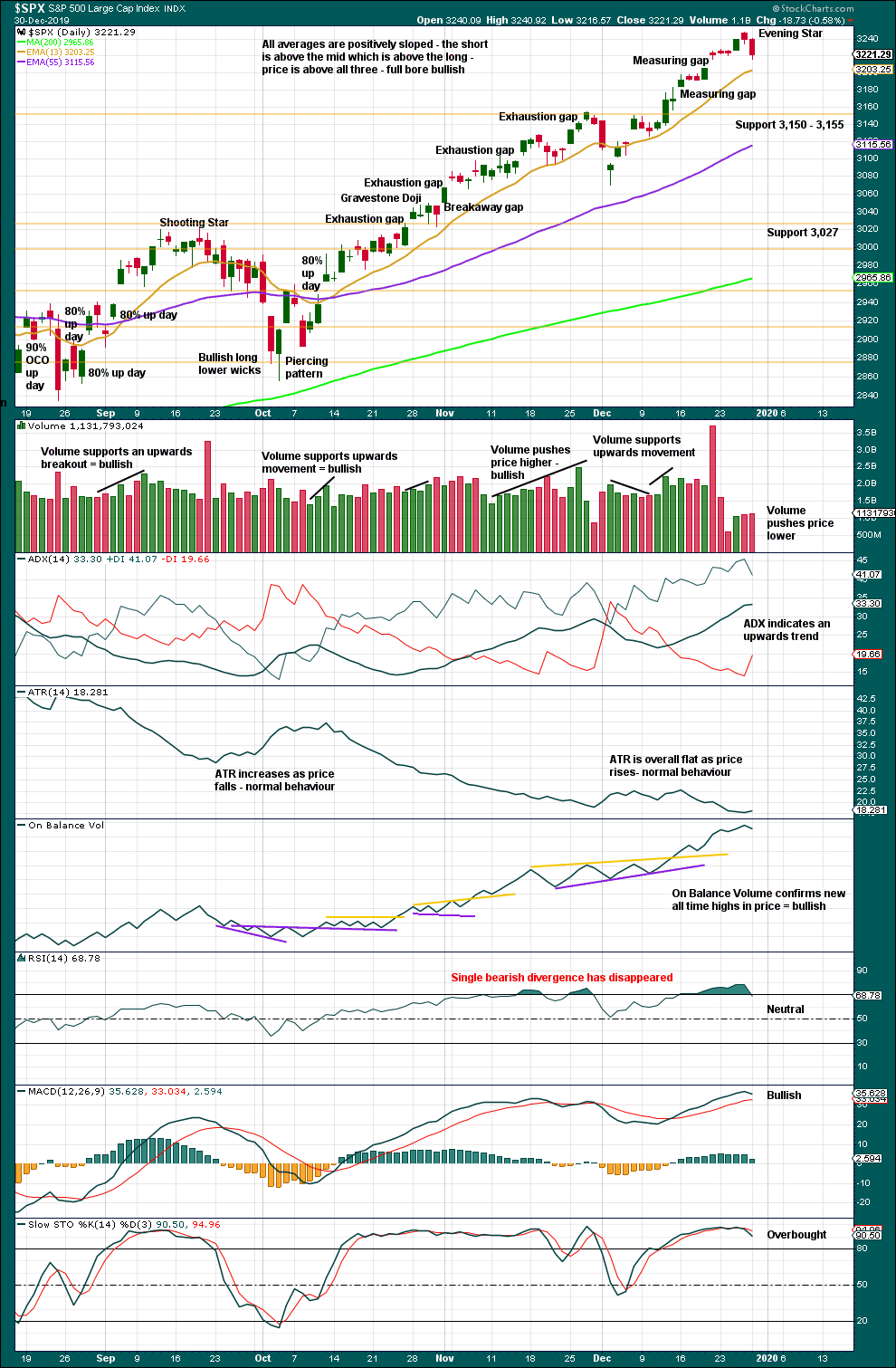
Click chart to enlarge. Chart courtesy of StockCharts.com.
There is an upwards trend in place. There will be corrections along the way.
Like the weekly chart, this chart is bullish.
With RSI overbought at both daily and weekly time frames, members are advised to pay careful attention to risk management. A larger pullback or consolidation will come to relieve extreme conditions.
Today completes a bearish candlestick reversal pattern in an Evening Star. The third candlestick has a little support from volume. However, down volume today was only 56% of total up/down volume; this downwards session is not particularly strong.
The bearish Evening Star suggests the risk here of a pullback or a more time consuming consolidation has increased.
BREADTH – AD LINE
WEEKLY CHART

Click chart to enlarge. Chart courtesy of StockCharts.com. So that colour blind members are included, bearish signals
will be noted with blue and bullish signals with yellow.
Bear markets from the Great Depression and onwards have been preceded by an average minimum of 4 months divergence between price and the AD line with only two exceptions in 1946 and 1976. With the AD line making new all time highs last week, the end of this bull market and the start of a new bear market is very likely a minimum of 4 months away, which is mid March 2020.
In all bear markets in the last 90 years there is some positive correlation (0.6022) between the length of bearish divergence and the depth of the following bear market. No to little divergence is correlated with more shallow bear markets. Longer divergence is correlated with deeper bear markets.
If a bear market does develop here, it comes after no bearish divergence. It would therefore more likely be shallow.
All of small, mid and large caps have made new swing highs above the prior swing high on the 13th of September, and mid caps have now made new all time highs. This upwards movement appears to be mostly driven by large caps, which is a feature of aged bull markets. This bull market at over 10 years duration certainly fits the definition of aged.
Again both price and the AD line have made new all time highs. There is no divergence. Upwards movement has support from rising market breadth.
Large caps all time high: 3,247.93 on 27th December 2019.
Mid caps all time high: 2,071.85 on 27th December 2019.
Small caps all time high: 1,100.58 on 27th August 2018.
DAILY CHART
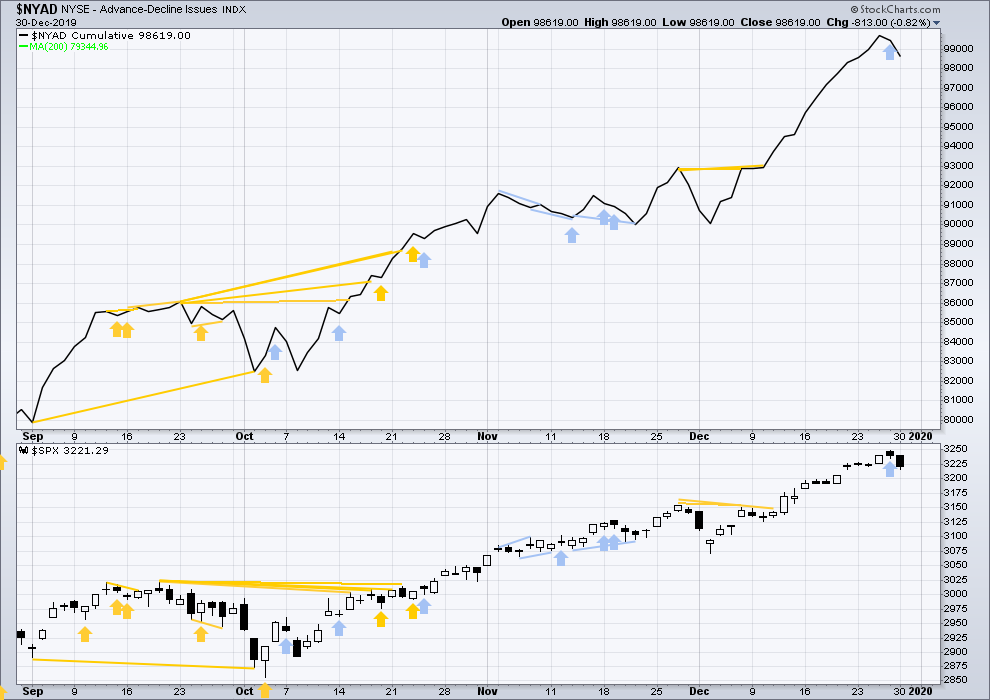
Click chart to enlarge. Chart courtesy of StockCharts.com. So that colour blind members are included, bearish signals
will be noted with blue and bullish signals with yellow.
Breadth should be read as a leading indicator.
The last session exhibited bearish divergence. This has now been followed by a downwards session. The divergence may now be resolved, or it may yet be followed by more downwards movement.
Today price and the AD line have both moved lower. Downwards movement has support from falling market breadth. Breadth is not falling any faster than price. There is no new divergence.
VOLATILITY – INVERTED VIX CHART
WEEKLY CHART
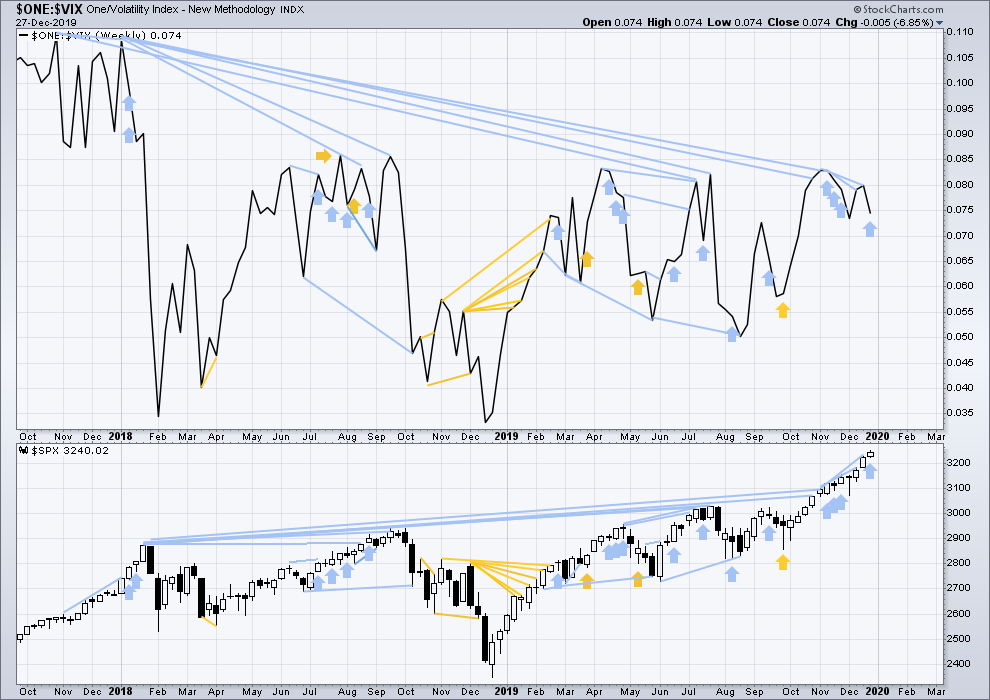
Click chart to enlarge. Chart courtesy of StockCharts.com. So that colour blind members are included, bearish signals
will be noted with blue and bullish signals with yellow.
The all time high for inverted VIX was on 30th October 2017. There is now over two years of bearish divergence between price and inverted VIX.
The rise in price is not coming with a normal corresponding decline in VIX; VIX remains elevated. This long-term divergence is bearish and may yet develop further as the bull market matures.
This divergence may be an early warning, a part of the process of a top developing that may take years. It may is clearly not useful in timing a trend change from bull to a fully fledged bear market.
Last week price has moved higher, but inverted VIX has moved lower. This single week of bearish divergence may be a warning that minor wave 4 may have arrived, or it may yet develop further before minor wave 4 arrives.
DAILY CHART
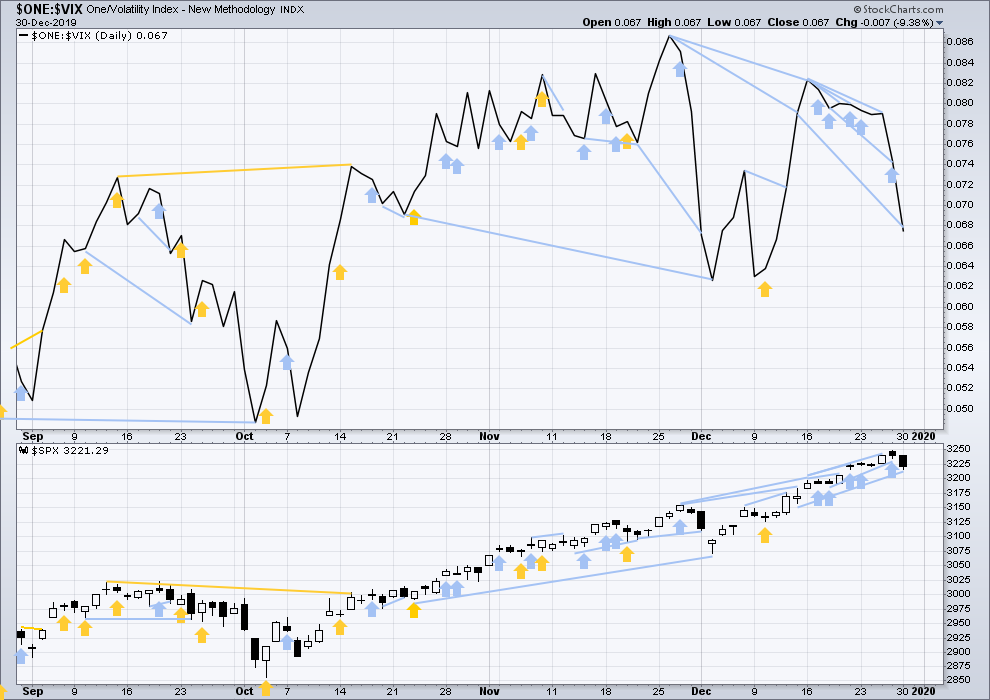
Click chart to enlarge. Chart courtesy of StockCharts.com. So that colour blind members are included, bearish signals
will be noted with blue and bullish signals with yellow.
Last session exhibited bearish divergence. This has now been followed by downwards movement.
Today both price and inverted VIX have moved lower, but inverted VIX is falling faster than price. Inverted VIX has made a new low below the prior low of the 13th of December, but price has not. This divergence is bearish.
DOW THEORY
Dow Theory confirmed a bear market in December 2018. This does not necessarily mean a bear market at Grand Super Cycle degree though; Dow Theory makes no comment on Elliott wave counts. On the 25th of August 2015 Dow Theory also confirmed a bear market. The Elliott wave count sees that as part of cycle wave II. After Dow Theory confirmation of a bear market in August 2015, price went on to make new all time highs and the bull market continued.
DJIA: 23,344.52 – a close on the 19th of December at 23,284.97 confirms a bear market.
DJT: 9,806.79 – price has closed below this point on the 13th of December.
S&P500: 2,532.69 – a close on the 19th of December at 2,506.96 provides support to a bear market conclusion.
Nasdaq: 6,630.67 – a close on the 19th of December at 6,618.86 provides support to a bear market conclusion.
With all the indices having moved higher following a Dow Theory bear market confirmation, Dow Theory would confirm a bull market if the following highs are made:
DJIA: 26,951.81 – a close above this point has been made on the 3rd of July 2019.
DJT: 11,623.58 – to date DJT has failed to confirm an ongoing bull market.
S&P500: 2,940.91 – a close above this point was made on the 29th of April 2019.
Nasdaq: 8,133.30 – a close above this point was made on the 26th of April 2019.
Published @ 06:32 p.m. EST.
—
Careful risk management protects your trading account(s).
Follow my two Golden Rules:
1. Always trade with stops.
2. Risk only 1-5% of equity on any one trade.
—
New updates to this analysis are in bold.

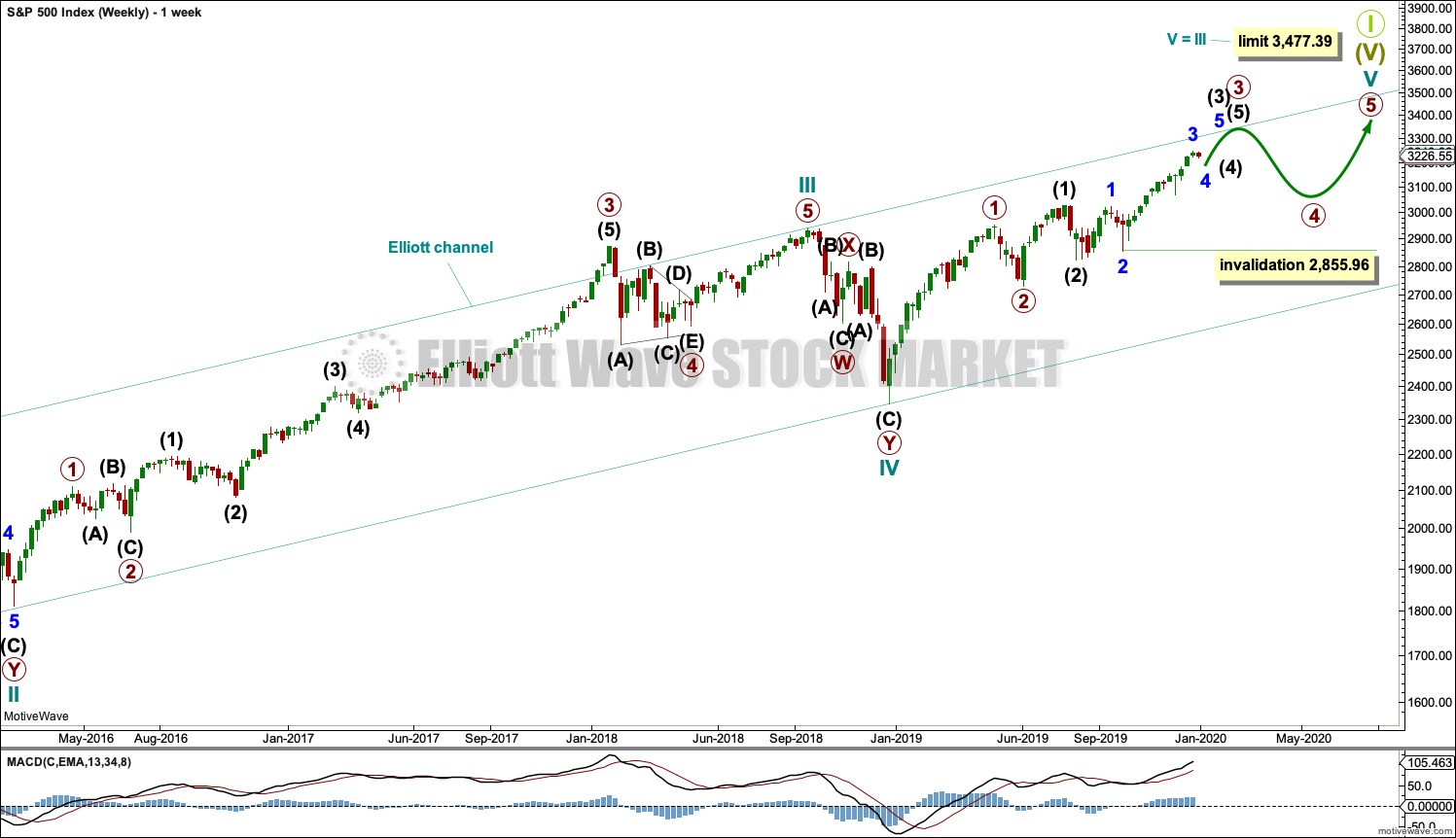
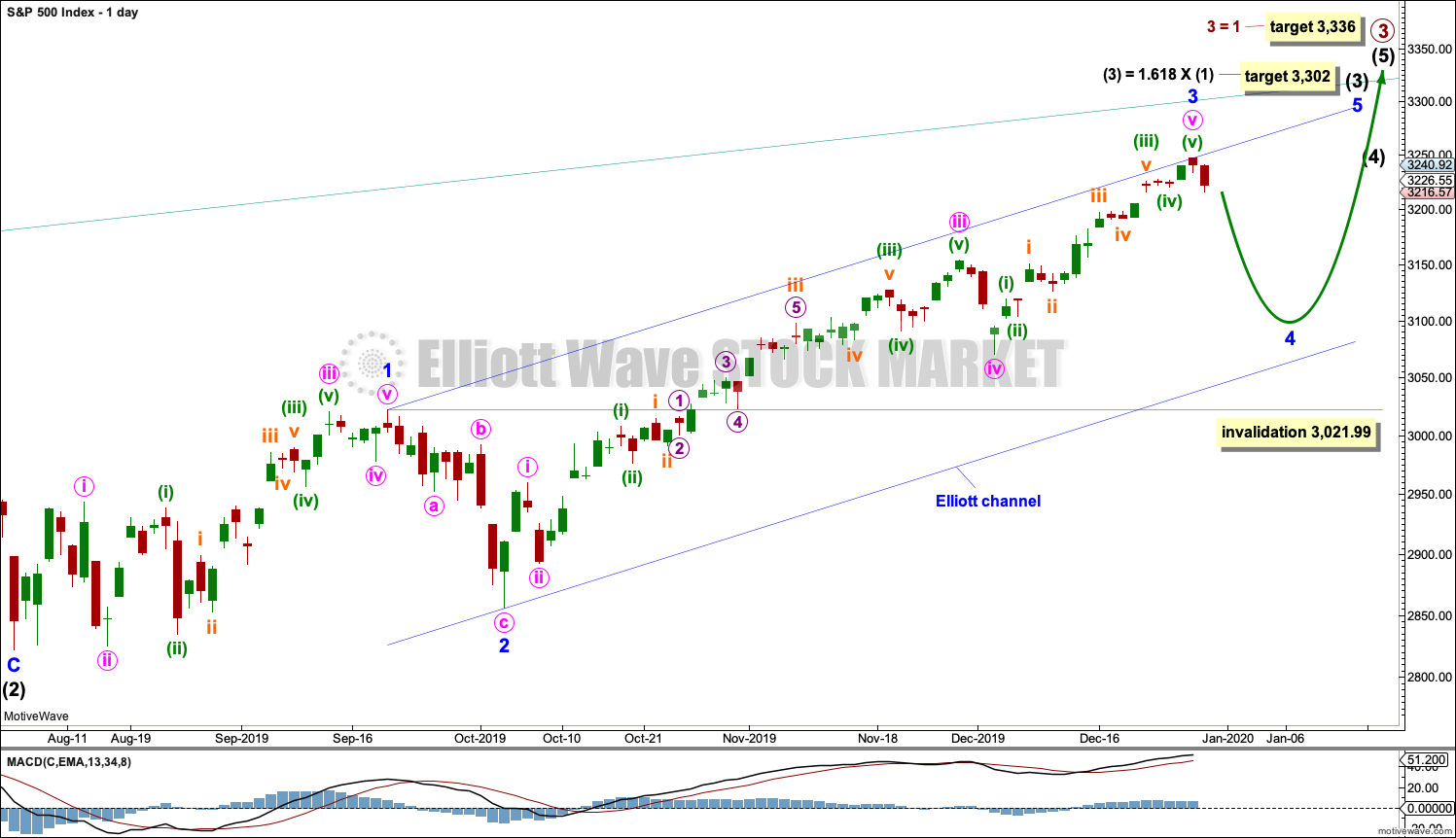
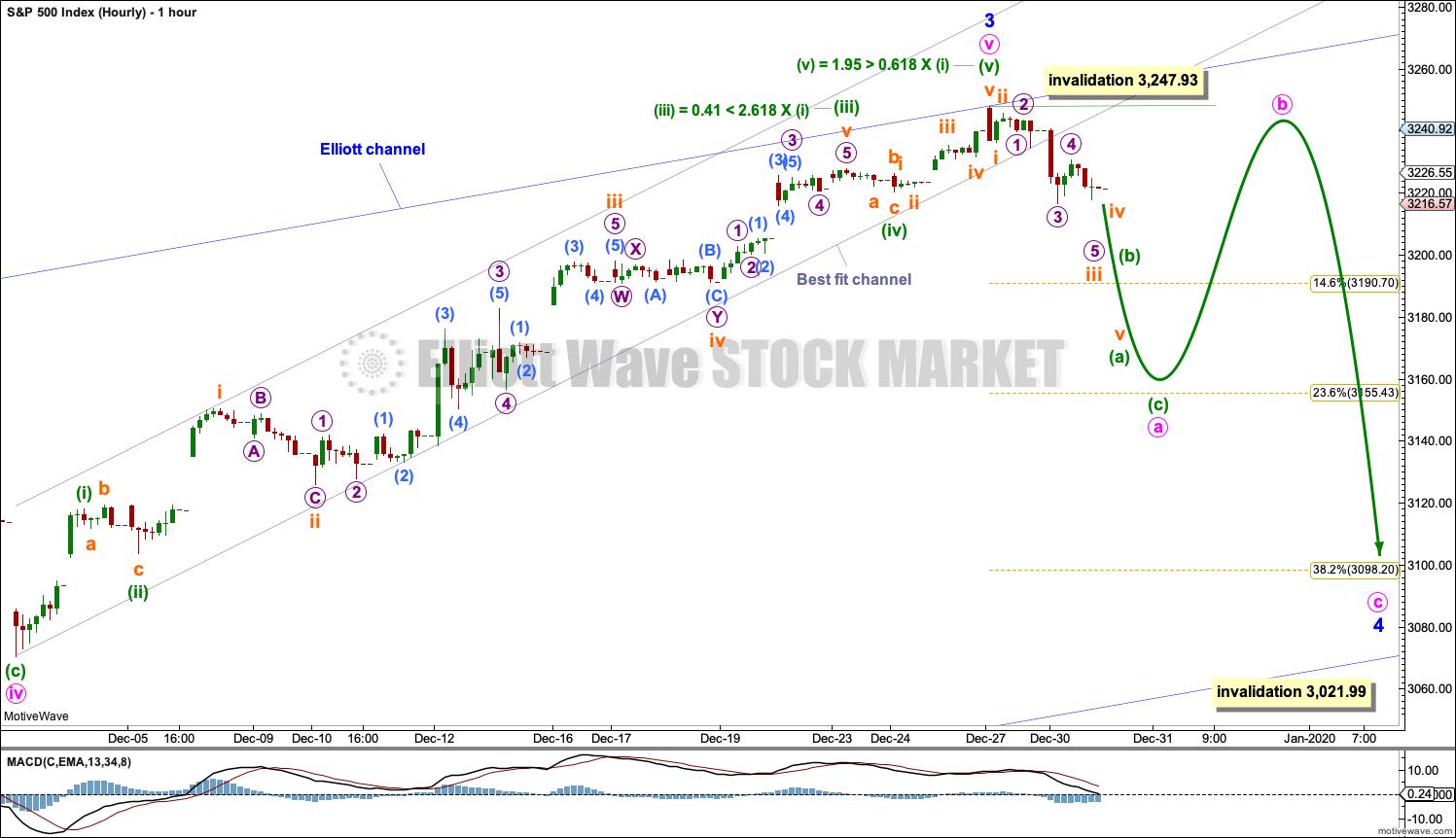
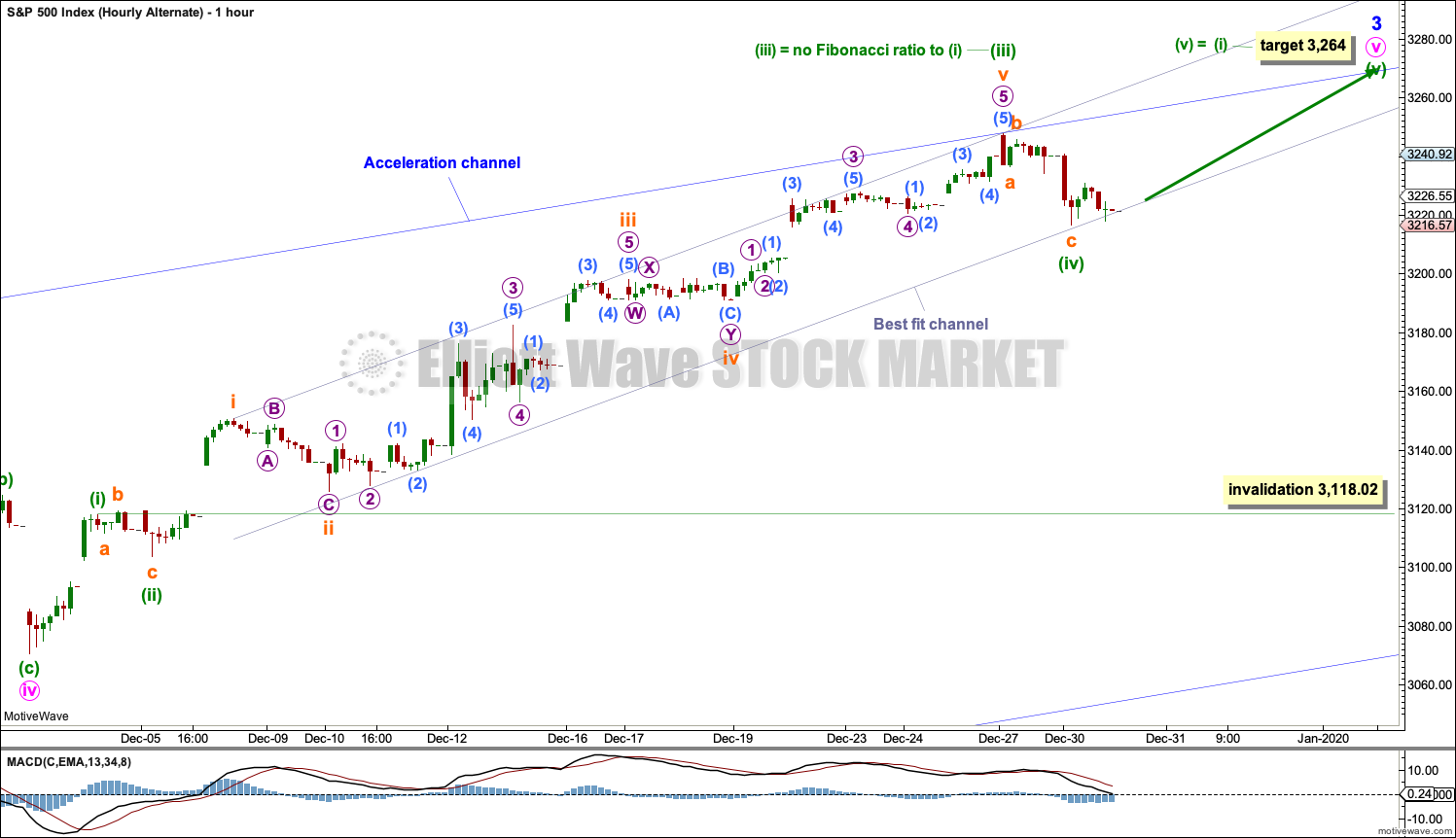
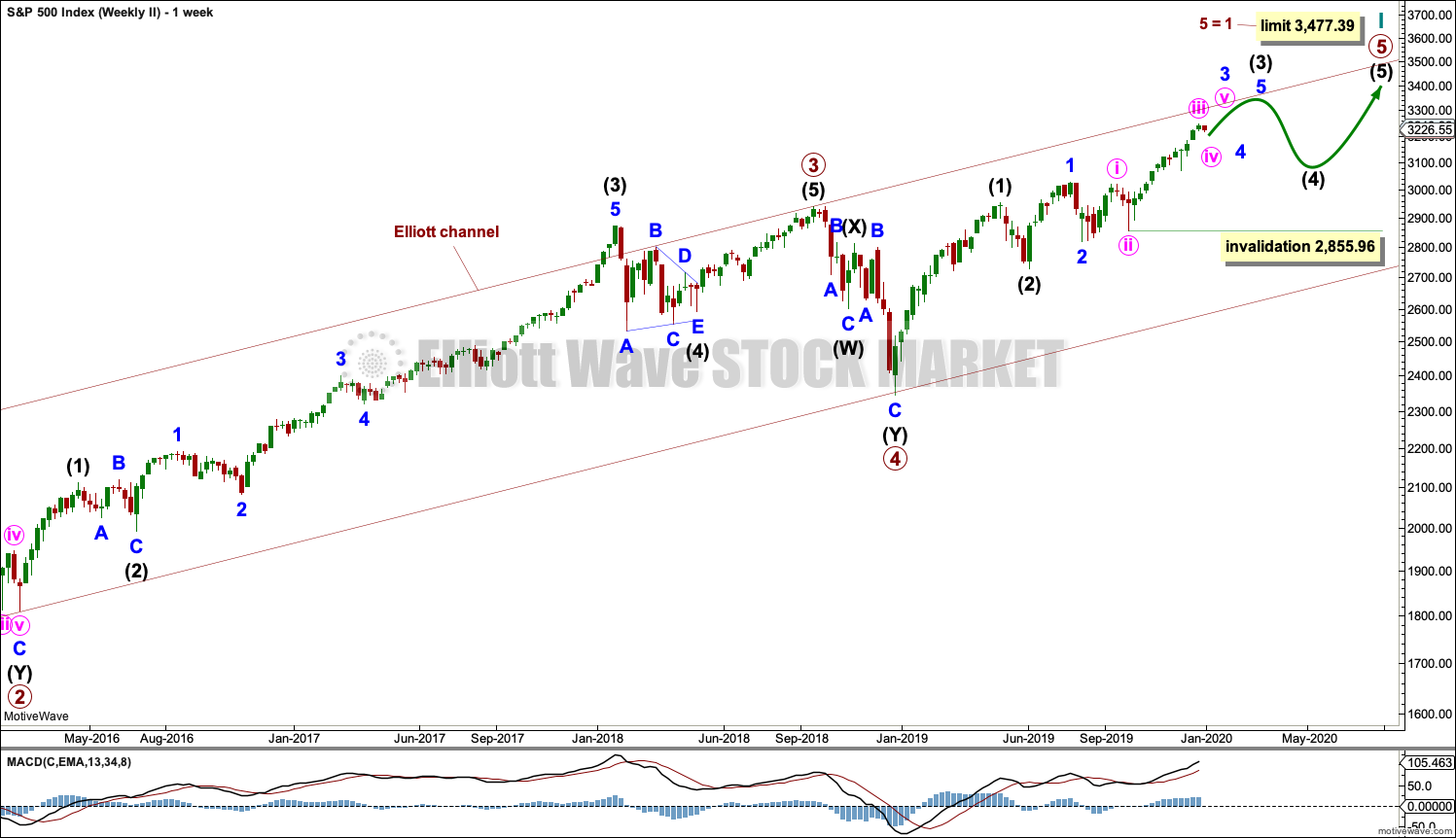
Main hourly updated:
So far this looks more likely. The proportions within minor 3 are good.
Alternate hourly chart updated:
I’ve adjusted the best fit channel to contain all of this movement. The first line is drawn on the highs of sub-micro (3) within micro 3 within subminuette v, to the last high, then a parallel copy is pulled down to sit on the lows of subminuette ii and micro 2 within subminuette iii. This then shows where so far today has found support for minuette (iv).
This channel is drawn as conservatively as possible.
This wave count remains valid
The target for this alternate needs to be recalculated. It’s now 3,260
Hmmm.
Discretion is the better part of valor. I closed many of my short positions for small profits (“any profit you can walk away with is a good profit!”), and will reload on them when there is confirmation of the 4.
I took a small short position yesterday. Stopped out this afternoon for a small, tolerable loss. I’m thankful for stops!
and a Happy New Year to you Lara, (few hours still to go here in Scotland).
Thanks for that alt chart, i closed off my shorts earlier with excellent profit (virtual cheers to you) have now went long given that wave 4 has just been breached.
Lets see if the market can close out 2019 (NYT) with that all time high, you never know.
All the very best to you and Cesar in 2020.
Thank you very much Dewpoint.
The session closed strongly and up volume has dominated, with support. On Balance Volume and the AD line made new all time highs today so I’m swapping the main and alternate hourly counts over.
I’m in Christchurch today, hunting for waves. I may have some to surf after work today. Beginning the New Year as we intend to continue…
A couple of notes: the pot stocks (I track CRON and CGC) have broken hard to the upside today, after massive 2019 sell off and a long basing period on top of Fibonacci 76-78% retrace levels. I’m in CRON as of last week, kind of anticipating the bottom was likely in.
On the shorting side (anticipating the minor 4 in the broader markets), I really like PG, which when nowhere in the latter half of 2019, and has a well defined double top. I’ve sold a call spread there for mid Feb 125/130.
hard not to notice all those signals of topping on the daily chart: RSI dropping back to neutral, stochastics rolling over, MACD approaching a bearish cross, and the DI+/DI- suddenly aiming directly at each other.
I appreciate the alternate hourly; the verdict remains open, with pretty clear confirmation/invalidation levels for the two short term alternatives.
I’m rather suspicious we get a final little rally, maybe to form a very tight double top, tomorrow…and that’s it. Thursday opens down sharply. Alternatively, I did have somewhat higher wave 3 completion levels giving slightly better Fibonacci structure in both SPX and RUT. Getting to those probably requires more up Thursday/Friday, and would be very consistent with the alternate hourly. So a bit of wait and see here.
Got it!
Got that.
And that’s 20 points for Curtis. Well done!
Happy New Year everybody!
It should be 19 points for the end of 2019. Next year it will be worth 20. Just sayin’………..
oh my gosh, point inflation…
I need my accumulated points to RETAIN VALUE!!
Happy New Year Everyone. Lara, great great year of analysis, thanks.